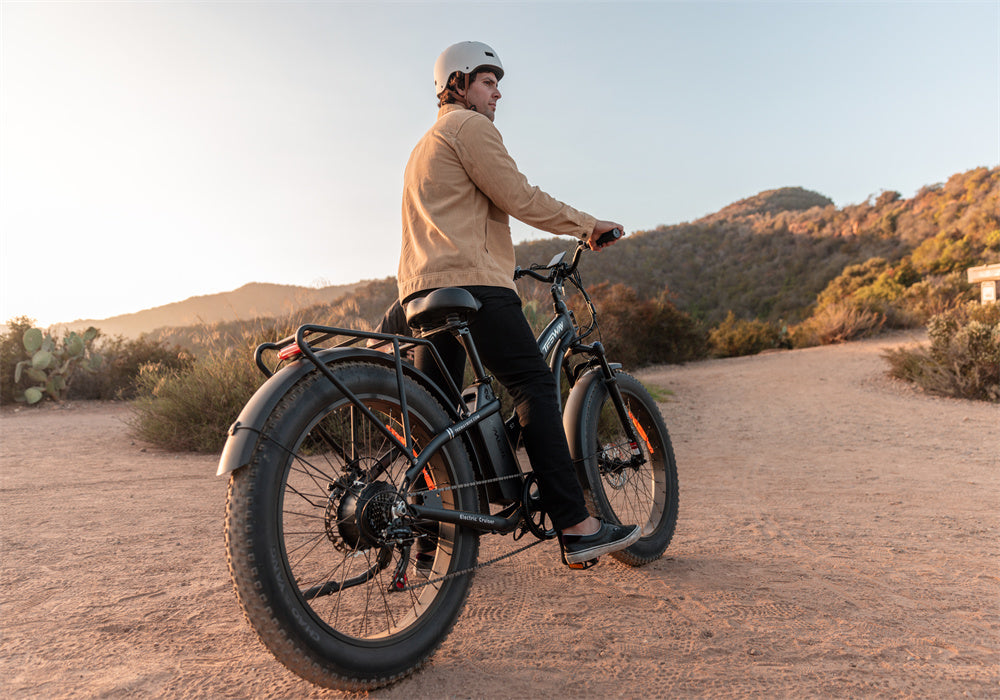Fat tire ebikes have surged in popularity, captivating cycling enthusiasts and fitness buffs alike. With their distinctively wide tires and robust build, these bikes promise a unique riding experience.
The Evolution of Mountain Bike Tires
For decades, mountain bikes were synonymous with 26-inch wheels, featuring a tire diameter of approximately 22 inches (559 mm) and a tire height of about 2 inches.
TESWAT's fat tire line is great if you're considering a 26inch fat tire ebike(tested by experts). Click to learn more!
However, the early 2000s witnessed the rise of the "29er," a wheel and tire size boasting a 24.5-inch (622 mm) diameter, akin to the "700c" road bike wheel. This size gained favor for its perceived ease in climbing over obstacles.
Meanwhile, some riders still preferred the nimble handling of smaller diameter wheels. The industry responded with the 27.5-inch or "650b" wheel size, striking a balance with a rim diameter of around 23 inches (584 mm).
As wheel sizes evolved, so did tire widths. Fat bike tires, measuring 3.8 inches (96.5 mm) or wider, were designed for soft snow and sand. "Plus tires," ranging from 2.6 inches (66 mm) to 3 inches (76 mm), offered a compromise, trading some of the original 29er's speed for increased tire volume and traction.
Today, "29+" tires represent the pinnacle in diameter and width, catering to endurance mountain biking and bikepacking enthusiasts.
Simultaneously, rim widths also evolved. Traditionally, rims with an 18 or 19 mm internal width, similar to those used on road racing bikes, were common. Over the past decade, rim widths have increased, balancing wheel stiffness, tire stiffness, weight, and strength.
Modern rim widths, chosen based on real-world use and market benchmarks, enhance the performance of various tire sizes.

Tire Texture and Friction
Tire texture plays a crucial role in performance and safety. The contact patch, where the tire meets the ground, deforms under load, creating lateral and longitudinal friction necessary for traction.
Knobs on the tire localize these shear stresses, enhancing grip during maneuvers such as slipping, cambering, driving, and braking. Even for car tires, localized pressures can be up to ten times greater than the average, depending on the tread pattern.
When it comes to fat tire electric bikes, the common belief is that wider tires provide superior traction. The 26×4” fat bike tire, for instance, has the longest and widest contact patch, followed by the 29×3” plus tire, 29×2.3” knobby tire, and the 27.5×2.8” tire.
However, the length of the contact patch is not solely dependent on the outer diameter but also on factors like inflation pressure, vertical load, and tire carcass.
In terms of contact area width, a 26-inch fat tire offers a broad footprint, providing excellent grip on various terrains.
However, the void ratio— the proportion of empty space between the tread knobs—also plays a significant role.
A higher void ratio means better grip in loose conditions like mud and snow, whereas a lower void ratio favors hard, rocky surfaces.
Inflation Pressure on Fat Tires
Inflation pressure is another critical factor influencing the performance of fat tire bicycles. Lower pressure increases the tire's contact area with the ground, enhancing grip and comfort.
For instance, a 29 × 2.3” knobby tire at 25 psi (1.7 bar) offers a different footprint than a 29 × 2.3” slick tire at the same pressure. The 29 × 2.3” knobby tire provides the widest and longest contact patch among the four tires tested.
Lowering the pressure also improves ride comfort by allowing the tire to absorb more shocks from rough terrain. However, it can increase rolling resistance, making it harder to pedal, especially on smooth surfaces.
Conversely, higher pressure reduces rolling resistance, improving efficiency on paved roads but compromising grip and comfort on rough trails.

Rider Weight on Fat Tires
The weight of the rider is another critical factor that impacts the performance of fat tire ebikes. Heavier riders exert more force on the tires, affecting the size of the contact patch, rolling resistance, and overall ride comfort. We can prove this with data and calculations.
Contact Patch Area Calculation with Varying Rider Weight
Using the formula for the contact patch area :
Let's consider two riders: one weighing 700 N (approximately 157 lbs) and another weighing 1000 N (approximately 220 lbs). Assume the tire pressure is 70 kPa (approximately 10 psi).
For the 700 N rider:
For the 1000 N rider:
The contact patch area for the heavier rider is approximately 43% larger than that of the lighter rider, resulting in better traction but increased rolling resistance.
Rolling Resistance Calculation
Rolling resistance is given by:
Assume a rolling resistance coefficient = 0.005.
For the 700 N rider:
For the 1000 N rider:
The rolling resistance force for the heavier rider is 5 N, compared to 3.5 N for the lighter rider. This higher rolling resistance indicates that the heavier rider will need to exert more effort to maintain the same speed.
Practical Example
Consider two riders on the same fat tire ebike trail. The heavier rider (220 lbs) notices that while they have better traction and stability on loose surfaces, they also find it harder to maintain high speeds on paved sections due to the increased rolling resistance. The lighter rider (157 lbs), on the other hand, enjoys easier pedaling on smooth trails but may struggle with traction in loose conditions.

The Physics of Fat Tire E-Bikes: Deep Analysis with Real-Life Calculations
By analyzing this through the lens of physics, we can better understand why a fat tire e-bike is also a great choice.
Traction and Contact Patch Dynamics
Traction is crucial for any bicycle, determining its ability to maintain grip on various surfaces. For bikes with fat tire, traction is significantly enhanced due to the larger contact patch—the area of the tire in contact with the ground.
Contact Patch Calculation
The contact patch of a tire can be analyzed through principles of deformation and load distribution. When a fat tire rolls over a surface, it deforms under the weight of the bike and rider, creating a larger contact area compared to narrower tires. This deformation spreads the load over a bigger area, reducing the pressure per unit area.
Let's consider a fat tire ebike with the following parameters:
- Weight of the bike and rider = 1000 N (approximately 220 lbs)
- Tire pressure = 70 kPa (approximately 10 psi)
Thus, the contact patch area is approximately 0.0143 square meters.

Rolling Resistance
Rolling resistance is the force resisting the motion of the tire as it rolls over a surface. It depends on factors like tire material, surface roughness, and deformation. Fat tires have higher rolling resistance due to their larger contact patch and greater deformation.
Rolling Resistance Calculation
Rolling resistance can be modeled by:
Assume:
- Rolling resistance coefficient = 0.005 (typical for fat tires on hard surfaces)
- Normal force = Weight = 1000 N
This means that the rolling resistance force acting against the motion of the bike is 5 N.

Impact of Inflation Pressure
Inflation pressure significantly affects tire performance. Lower inflation pressures, common in fat tires, increase the contact patch size and improve traction but also raise rolling resistance. Higher pressures reduce the contact patch, lowering rolling resistance but also decreasing traction and comfort.
Deformation and Pressure Distribution Calculation
At lower pressures, fat tires exhibit greater deformation, increasing the contact patch area. The pressure distribution over this area follows Hertzian contact mechanics, where the pressure is highest at the center and gradually decreases towards the edges.
Given:
- Central pressure = 70 kPa
- Contact patch radius = 0.1 m (assuming)
At :
At (halfway to the edge):
This shows how the pressure decreases from the center to the edge of the contact patch.

Energy Dissipation and Heat Generation
As fat tires deform, energy is dissipated through hysteresis in the tire material, leading to heat generation. The degree of hysteresis, and consequently energy loss, is higher in fat tires due to their larger deformation.
Assume the average stress = 50 kPa and strain = 0.05 over the contact area:
For a contact area of 0.0143 square meters:
This represents the energy dissipated per square meter of the contact area.
Stability and Maneuverability
Fat tires enhance stability due to their larger contact patch, which distributes the rider's weight more evenly and provides better grip. This is particularly beneficial on loose or uneven surfaces. The increased contact area reduces the likelihood of slipping, making ebikes with fat tire safer on varied terrains.
However, the increased surface area and mass of the tires can affect maneuverability. The moment of inertia of the wheels increases, making it harder to initiate and stop rotation.
Moment of Inertia Calculation
Assume:
- Mass of the tire = 2 kg
- Radius = 0.3 m
This higher moment of inertia means more torque is needed to change the rotational speed, impacting maneuverability.

Where You Can Buy the Best Fat Tire Electric Bike
Finding the perfect blend of quality, performance, and affordability in fat tire electric bikes can be challenging. TESWAY stands out as a leading brand in the electric bicycle market in the United States, delivering top-notch products that meet diverse rider needs.
TESWAY's fat tire electric bikes boast advanced, flexible disc brakes designed to prevent slipping on wet roads, ensuring safety in various weather conditions. Whether navigating city streets or exploring rugged terrains, TESWAY bikes offer the stability and control you need.
The S7 model in TESWAY's fat tire electric bike series is popular for its exceptional performance and affordability. As satisfied customer Tommy noted, "This is the best fat tire e-bike I've ever bought, and it's not expensive at only $1,059.99. It fits my needs perfectly, whether for shopping or running errands around town. Even on long journeys, the S7 is a no-brainer.”
Conclusion
The physics behind fat tire ebikes highlights their benefits and trade-offs. Enhanced traction and stability, due to larger contact patches and lower inflation pressures, come at the cost of increased rolling resistance and energy dissipation.
Whether you're commuting, shopping, or embarking on long journeys, TESWAY has the perfect bike for your needs. Visit TESWAY's website or your local dealer to make your purchase today!
FAQs
Why do heavier riders experience more rolling resistance on fat tire eBikes?
Heavier riders experience more rolling resistance because the increased weight leads to a larger contact patch, resulting in greater deformation and energy loss as the tire rolls.
How does rider weight affect tire contact patch size?
Rider weight directly affects the contact patch size; a heavier rider increases the force on the tire, expanding the contact patch and enhancing traction.
What is the trade-off between traction and rolling resistance for heavier riders?
Heavier riders gain better traction due to a larger contact patch but face increased rolling resistance, making it harder to pedal on smooth surfaces.







Share:
7 Best Electric Bikes for Adults in the US | We have Tested
Ebike Motor: Everything Explained